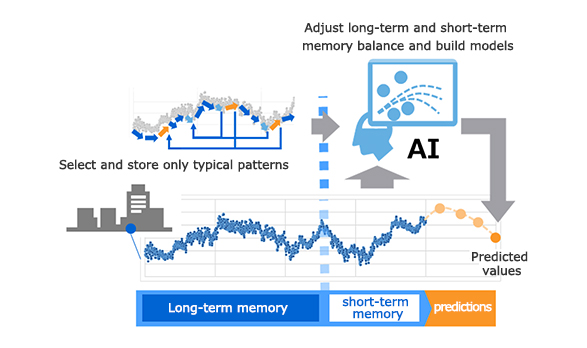Toshiba's AI Breakthrough for Edge Devices Uses Both Short-Term and Long-Term Memory to Deliver Highly Precise Predictions
-Improves capacity utilization of plant and equipment and social infrastructure, reduces maintenance costs-
Toshiba Corporation
The great promise of IoT in the industrial sector is improved productivity and efficiency from increased capacity utilization, fewer equipment malfunctions, and lower maintenance costs. Toshiba Corporation (Tokyo: 6502) is realizing this with OPOSSAM, its newly developed "Online Prediction Method of Stream Data with Self-Adaptive Memory." A major advance in AI for edge devices, OPOSSAM continuously harvests real time data streams from numerous sensors installed in production systems and social infrastructure, and delivers highly accurate predictions of future system status and of the need for and timing of maintenance.
The inspiration for the new technology is human memory management. Alongside recent data trends found in short-term time series, OPOSSAM also draws on long-term memory and past repetitions of trends, and makes balanced use of both in analysis. In order to bring this capability to edge devices, it also uses the characteristic patterns found in long-term trends, reducing demands on memory capacity. By verifying performance against public benchmark data for transportation and other infrastructure, Toshiba has confirmed a 13% improvement in accuracy over current data stream technologies.
Toshiba announced the details of OPOSSAM at the IEEE International Conference on BIG DATA 2018 in Seattle, USA(Note 1).
Advances in sensor technology and the ever wider use of industrial IoT have made it easier than ever to harness huge volumes of data from industrial processes. For factory operations and social infrastructure, which generate constant flows of data streams that change over time, real time data analysis is an increasingly effective tool for boosting capacity utilization and preventing equipment malfunction.
Making effective use of this data in industrial settings requires real-time forecasting technology that can consistently deliver accurate predictions of future values from numerous data streams. However, this must be done without relying on large-scale computers, as the edge devices that perform the analysis have limited computing and memory capabilities. This factor has led to the widespread adoption of a forgetting mechanism: today, the conventional approach to processing data streams that change over time is to focus on the latest data, and to discard old data. This approach fails to fully or accurately exploit changes over time, and results in problems with prediction accuracy.
As "OPOSSAM" carries out real time analysis of data streams, it uses errors between actual observed values and predicted values to automatically adjust the weighting give to short-term and long-term memory, allowing it to adapt to changes in data trends over time and to make highly accurate predictions. Furthermore, in selecting representative trend patterns for long-term memory storage, it focuses on redundant patterns, and deletes anomalous or noisy ones based on error prediction. This keeps data stored in long-term memory at a manageable level, and ensures successful operation on edge devices with limited memory capacity.
Drawing on knowledge and experience cultivated over many years as a manufacturer involved in a wide range of businesses, and by combining that with world-class strengths in information processing, digital and AI technologies, Toshiba Group is promoting its digital transformation toward becoming one of the world's leading cyber-physical systems (CPS) technology companies. OPOSSAM is one of the technologies that will support this transformation. Going forward, Toshiba will refine OPOSSAM's capabilities as a prediction technology able to understand relationships between multiple types of time series data, and apply the technology to predicting the real-time status of diverse social infrastructure, energy, and manufacturing systems.

- (Note 1)
- In addition to the conference, the technology was also covered by the International Journal of Data Mining Science.


